On the Road – Colorado Plateau
The Land Where Rock Dominates
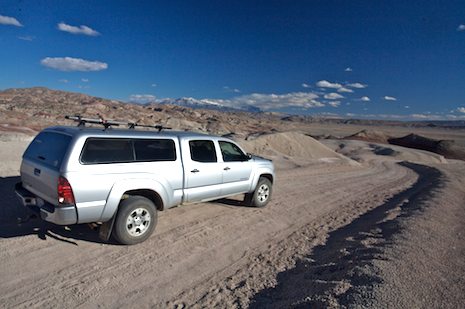
I’m up early today. The drive will not be a long one but there is plenty to see along the road that stretch from Zion National Park to Green River, Utah. The core of the route is along Highways 12 and 24. On the map they seem somewhat insignificant – just a bit more than a hundred miles total distance but this may be the finest drive you’ll ever take west of the Rocky Mountains.

The East Rim Drive leading up out of Zion to Mt. Carmel Junction is a favorite of mine. The road switches back and forth up out of the main canyon bringing finer and finer views at every turn. Just as its appears the road wiIl dead end at a huge headwall it enters a two mile long tunnel that is almost claustrophobic in its narrowness. Thankfully the drive is interspersed with windows that allow a quick peak out – then suddenly, I’m out in the bright light and the steep walls on either side bring the canyon right up to the edge of the car. From this point the road winds for ten miles up the Pine Creek drainage, a fairyland of high country geology, towering walls, deep side canyons and plenty of places to stop and explore. There are no trails, just bedrock. Be wary though: it’s easy to climb up the rock and much more difficult to descend back down.
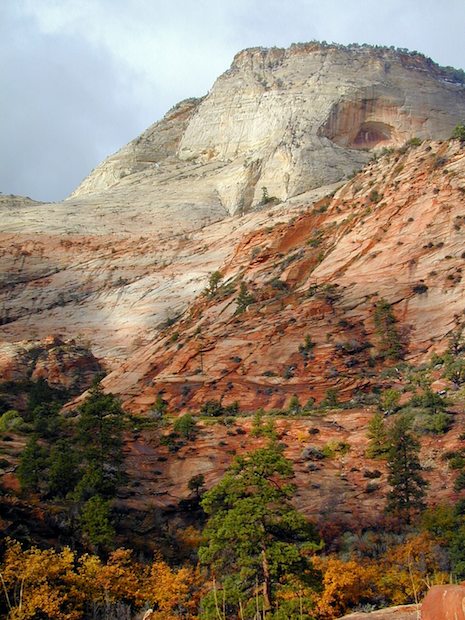
At Mt. Carmel Junction I turn north on Highway 89,a 40 mile stretch of road that meanders along a series of long, narrows valleys to the start of Highway 12. Two miles into the drive I pass through Red Canyon, then twenty minutes later I’m at the turnoff to Bryce Canyon. There is a cold, biting wind that scours the sparse scrub brush, peppering it with sand but nevertheless I am determined to take a hike into the canyon.
The landscape is filled with a geologic past that cannot be ignored. The bedrock layers that comprise Bryce and the larger the Colorado Plateau have colorful names – Moenkopi, Chinle, Morrison, Wingate, Kayenta, Navaho – and together they comprise thousands of feet of sedimentary rock formed in a succession of ocean, near-shore, river and sand dune environments. As each layer was laid down, its weight hardened the layers beneath, compressing and solidifying them, readying them for another part of the geologic story when the opposites of uplifting and erosive forces would take place, sculpting what I am driving through today.
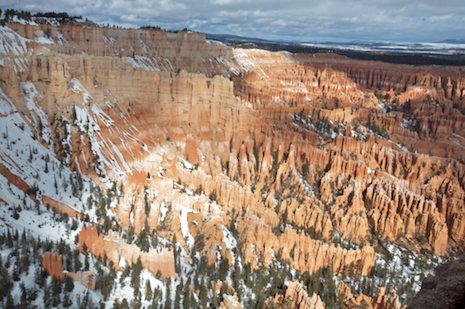
At Sunrise Point it is difficult to stand for long but once down off the rim the wind dies down to a point that I’m relatively comfortable. Near one particular spire that must have a name though I’m not sure what it is, there is a perfect spot to sit back and enjoy the view. The snow has kept most of the tourists away and the quiet feels good. In the distance I can spot bits and pieces of Boulder Mountain, the Grand Staircase – and on the far horizon across the deep chasm of the Grand Canyon the rounded top of Navaho Mountain.
The immediacy of the canyon beauty sits easily on my mind though it also distracts from an easy understanding of what the meaning of this land is to me. In the Southwestern parks like this the beauty is blinding: Most visitors find it enough to capture the view on film before moving on to the next scenic spot. It is a scenery that those who come from Europe or Asia find fascinating simply because it is so different from anything they know.
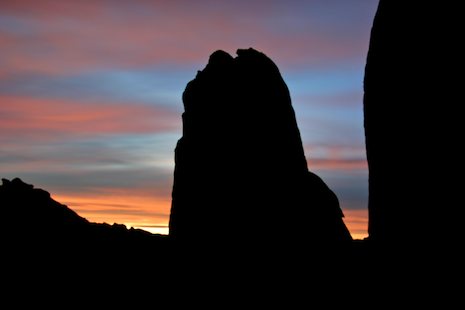
The Colorado Plateau covers slightly more than 130,00 square miles, most of it in Utah but good sized pieces in Colorado, Arizona and New Mexico as well. Pressured by tectonic forces in play along the Pacific and North American plates some 65 million years ago, the sediment-filled lands began to rise at the astonishing rate of an inch a year, not elevator speed but sufficient when viewed over millions more years to push it more than 5,000 in elevation. For me, in my lifetime, the land will move no higher than it does today which is to say not at all. The scale on which geologic forces operate take place over a period that is difficult to appreciate or understand.
As tough as it is to comprehend the forces that caused the land to rise, it is equally difficult to appreciate what has been scoured away and taken down rivers such as the Green or Colorado. Looking down towards the Paria River below me the land has been cut away thousands of feet, an amazing amount of sediment for such a tiny river as the Paria to have washed away.
“I have learned from all these experiences and been changed by them,” Wallace Stegner wrote, “Ths land cares not a fig for me, but I care for it. It’s strangely satisfying to encounter nature on its own terms, to learn to love places, as with people, for simply being themselves.”

This is a sentiment I can agree with wholly. I yell out a “Hello Canyon” greeting and after a few seconds I hear an echo but the canyon itself is silent. The rock here in Bryce Canyon is relatively young having been laid down only 50 or so million years ago. The layer is 1,300 feet thick, just tall enough to form the magical creatures that seem to be frozen in time here. Composed of mudstones, limestone and sandstone they work in perfect harmony. The mudstones form the graceful layering of the canyon terraces while the limestone serves to form the tall columns and chunks of more resistant dolomite sit atop the columns to protect them from erosion.
Back in Santa Barbara, a small piece of stone such as you can find at Lizard’s Mouth or the Rock Garden or in Seven Falls is a cause for celebration. Here, formations such as these in Bryce Canyon or the vast expanse that makes up the Colorado Palteau is overwhelming.
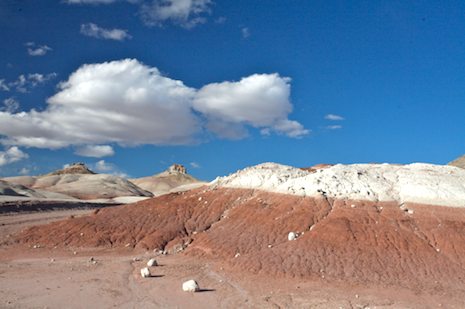
Moving on from Bryce Canyon, Highway 12 snakes its way through Grand Staircase country through Escalante, Boulder, Torrey and Hanksville to Green River. The rest of the drive confirms what I had experienced at my resting spot – the land will speak when I am ready to listen. This is a land that is difficult on which to impose one’s will. Mormons knew this intimately.
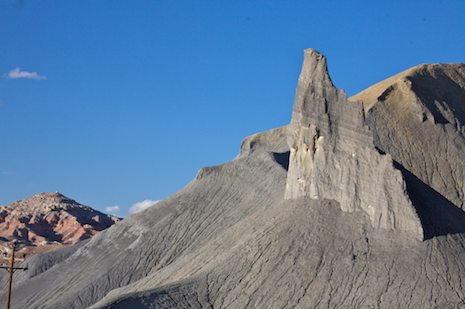
Perhaps what I get best out of the day is that what I’ve experienced has been a long time in the coming. Beneath the relatively short period of American history is a bedrock that shapes who we are whether we realize it or not.



